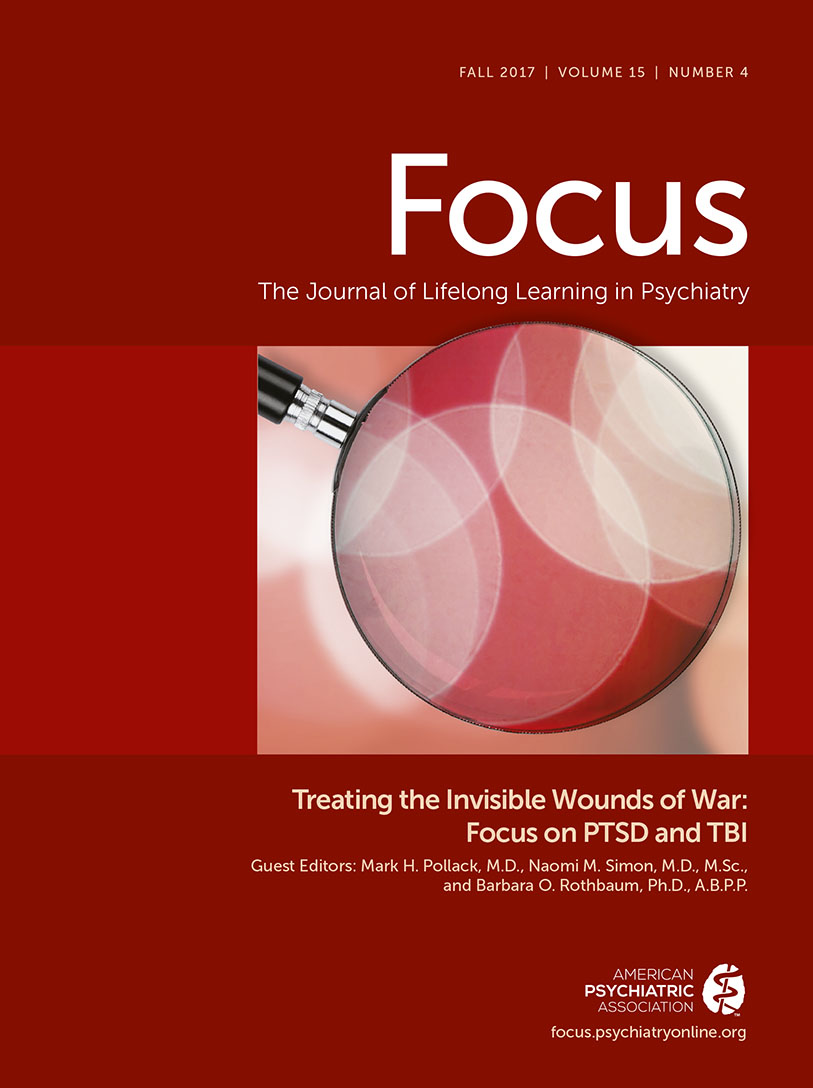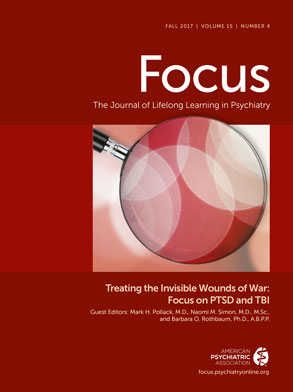Doctors, medical schools, hospitals, health-care systems need to find ways to foster an environment where everything we do starts with looking into our patients’ eyes and really knowing them.
—Harlan Krumholz, M.D. (
1)
Experiencing traumatic events is common, affecting an estimated 50%−75% of the general population. Individuals exposed to trauma have higher rates of mental disorders, including posttraumatic stress disorder (PTSD), depression, and interpersonal problems (
2). Studies suggest that approximately 10% of primary care patients meet diagnostic criteria for PTSD (
3,
4). Adversity, trauma, and PTSD predict increased rates of medical utilization, more intense physical symptoms, higher health care costs, more negative health outcomes, and greater severity of disability in patients (
3–
5). Survivors of interpersonal trauma are often reluctant to form and maintain trusting relationships and may be sensitive to how power and authority are used in relationships (
5). Patients who have experienced trauma, including those with clinical symptoms of PTSD, frequently report that their interactions and perceptions of their relationships with health care providers are more negative than those reported by patients without a trauma history (
6,
7). Thus, forming a therapeutic doctor-patient relationship that optimizes open, honest, and collaborative communication may pose special challenges when doctors are working with traumatized individuals.
Effective doctor-patient communication has been shown to be associated with higher patient satisfaction, improved health outcomes, and greater adherence to recommended treatment plans (
8,
9). However, a number of traumatic stress symptoms, such as intrusive thoughts and a tendency to avoid reminders of the prior trauma, may limit a patient’s capacity for open and effective communication with his or her physician (
10). A patient-centered approach to communication between clinicians and patients incorporates active listening, eliciting patient perspectives, partnership building, engaging the patient in participatory decision-making, and jointly developing the treatment plan (
11–
13). Patient-centered or—as proposed by Beach, Inui, and colleagues (
14)—“relationship-centered” doctor-patient communication increases the likelihood that the interaction will be closely aligned with the patient’s social and emotional needs. Building trust by using a relationship-centered approach is considered an essential component of trauma-informed patient care.
Vicarious Trauma, Compassion Fatigue, and Burnout
Psychiatrists in virtually all settings work with patients who are survivors of trauma. Patient traumas frequently encountered in clinical practice include childhood sexual abuse, physical or sexual assault, natural disasters, domestic violence, and violence experienced in school or work settings (
15). By empathically listening to explicit details of patients’ traumatic experiences, therapists become witnesses to and affected by the traumatic realities of their patients. Therapists working with traumatized patients are at high risk for vicarious traumatization—suffering effects of trauma by the very process of empathically listening and connecting to patients who share their trauma narratives. Vicarious traumatization may transform the psychological functioning of the therapist, with a negative impact on emotional, relational, and cognitive functioning (
16).
Empathy and compassion are essential ingredients of the therapeutic process in psychiatry. This is particularly true when psychiatrists are working with traumatized individuals, whose life experiences may have disrupted their ability to form trusting relationships. However, empathic attunement may extract a cost. As Figley noted,
In our effort to view the world from the perspective of the suffering we suffer. The meaning of compassion is to bear suffering. Compassion fatigue, like any other kind of fatigue, reduces our capacity or our interest in bearing the suffering of others. (
17, p. 1434)
Thus, the ability and motivation to empathize are key to both helping others and being vulnerable to the costs of caring. Figley (
17) has identified ten variables that, together, form a causal model predicting compassion fatigue. These variables facilitate an appreciation for what causes compassion fatigue and what is required to prevent and treat it: (a) empathic ability, (b) empathic concern, (c) exposure to traumatized patients, (d) empathic response, (e) compassion stress, (f) prolonged exposure to suffering patients, (g) traumatic recollections of the therapist, (h) life disruption of the therapist, (i) sense of achievement, and (j) disengagement. The last two variables are methods of decreasing compassion fatigue. The most powerful antidotes for compassion fatigue are a sense of joint achievement, collaboration, empowerment, hope, and positive gains. Disengagement, or the minimization of empathic connection, may decrease compassion fatigue but at the cost of threatening the therapeutic relationship at the core of the healing enterprise.
Burnout is characterized by a loss of interest in one’s work or personal life, feeling like one is just going through the motions. The burnout syndrome includes emotional exhaustion, treating people as if they were objects (depersonalization), and having a sense that work is no longer meaningful (low personal accomplishment). Burnout appears to alter both the physician-patient relationship and the quality of care physicians provide (
18). Thus, burnout is a serious threat to the well-being of the physician and of the patients the physician treats.
Combating Burnout
Institutions and training programs are adjusting to meet the need for wellness initiatives to combat burnout. These initiatives may include individual interventions, such as recreation, exercise, meditation, and self-care activities. Feeling that one’s work is meaningful is particularly important for morale and effective practice (
18). Regular reflection on those aspects of professional activities that provide meaning, purpose, and professional fulfillment—the ability to feel effective and creative, to lead a life of purpose that is balanced with one’s value system, and to realize one’s potential is an attribute of emotional and spiritual health (
19)—enhances job satisfaction. Seligman and Csikszentmihalyi (
20) described the meaningful life as “knowing your highest strengths and using them in service of something larger than [yourself].” They noted that the pursuit of meaning has the strongest correlation with life satisfaction. When physicians feel professionally fulfilled, patients are more likely to feel satisfied, to comply with treatment, and to have greater trust and confidence in their physicians.
Lieff (
21) has described meaningful work as the realization of one’s potential and purpose—the point at which a person’s passions, strengths, and core values interact synergistically in his or her work:
Reflecting on one’s past, current, or aspired-to activities can yield information about the occasions when one’s passions, values, and strengths connected in a synchronous way. Such occasions are opportunities for recognizing and reflecting on what is personally meaningful work and what are one’s core beliefs about meaning and purpose in work life. (
21, p. 1384)
Career development may also enhance career satisfaction. Ongoing education and training to improve one’s practice is an aspect of lifelong learning that can increase one’s effectiveness as a mental health provider. For example, Risking Connection is a mental health training curriculum that empowers clinicians to “respond to the complex needs of trauma survivors within the framework of growth-promoting relationships” (
22, p. 65). The program builds on constructivist self-development theory, which recognizes self-observation, the identification of emotional reactions, and attending to one’s own self-care as aspects of practitioner training (
22).
Tips for Enhancing Personal Resilience as a Caregiver
Professional fulfillment, work-life balance, and self-care practices may all contribute to effectiveness as a clinician. Flight attendants’ message about what to do when experiencing a loss of cabin pressure applies here metaphorically: “Put on your own (oxygen) mask first before helping others.” Caring for oneself ensures that one retains the optimal capacity to care for others. Below are tips for enhancing personal resilience as a caregiver and optimizing meaning in one’s work:
Personal reflection: Crafting a brief autobiography that celebrates what you would like to be able to say about your successful career at the time of your retirement can tap into hopes, dreams, values, and aspirations. This narrative should be guided by the recognition that personal and professional life experiences shape one’s life choices. Use this exercise to set career and life priorities (
21).
Goal setting: Consider your own values, passions, and strengths while setting short- and long-term goals. Consider three headings to encompass work-life balance—Career, Relationships, and Hobbies and Interests—and set goals for each. Recheck your list every six months to monitor your progress and revise the list as necessary.
Lifelong learning: Effective practice entails keeping current with new developments in the field and gaining specific expertise in needed therapeutic skills. Ongoing skill development can invigorate your work.
Support network: Participate in your local specialty organization, form close relationships with valued colleagues, or develop a community network of meaningful and supportive relationships. Remember to nurture intimate relationships with family and friends.
Celebrate successes and learn from mistakes: Take note of and celebrate successes—even ones that may seem relatively minor, such as an improvement in the health of a very ill patient or a working collaboration that is going well. Use trying times or professional or personal missteps as opportunities to learn.
Self-care: Ensure that you make time to care for yourself. Healthy habits (e.g., attaining adequate nutrition, sleep, and exercise) can maintain vitality. Spending time with valued others can rejuvenate. Meditation, mindfulness, and other ways of caring for your own mental health and emotional well-being should be a priority. Take note of vicarious trauma, and be sure to treat it (e.g., through desensitization and interpersonal connectedness). Don’t forget—physicians and clinicians can and should seek therapy as needed.

